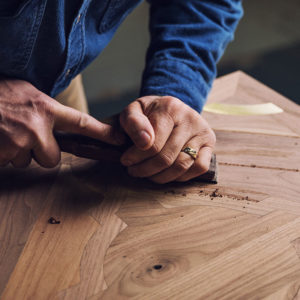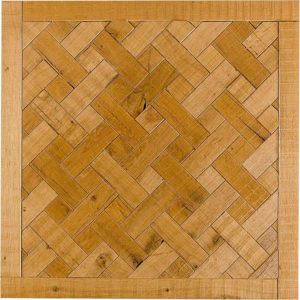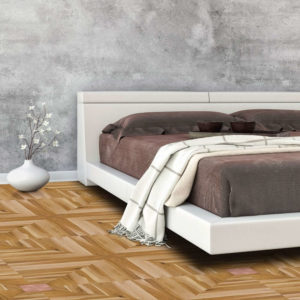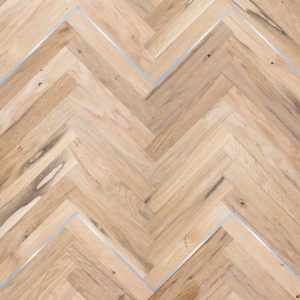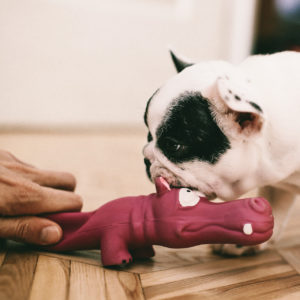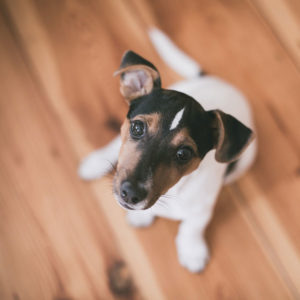
Not at all. For one thing, hardwood is naturally resistant to spills as long as they’re addressed right away. And there are plenty of options available to realistic homeowners who know they won’t be able to keep their floors in pristine condition. The key is choosing the right floor.
There are several factors to consider when seeking the look and longevity of hardwood flooring yet require the ability to take the wear and tear. Some wood species, for example, are harder and more resistant to abrasion than others. Some styles of flooring will hide scratches and pet hair better. And some textures and finishes can even make the dings look intentional.
Let’s take a look at some of the ways parents and pet-owners – or even just people who anticipate high traffic – can have great-looking hardwood floors without having to constantly worry over them.
Texturing
One excellent – and currently fashionable – choice for those who fear they’ll be unable to keep their floors looking pristine is to apply one of a number of forms of texturing. Texturing, as you might guess, involves various techniques to add texture to a floor.
Hand-Scraping and Wire-Brushing
Hand-scraping and wire-brushing are two texturing methods that create a more rustic look. The end result can help mask any damage caused by high traffic and pets. Pet hair and dirt will also be less visible.
Distressing
If you like the aged look, you might also consider distressed flooring. Distressing wood involves adding those marks, holes, and scrapes most homeowners seek to avoid. This helps achieve a naturally-aged, lived-in look. And it obviously helps mask any damage from kids and pets.
Reclaimed Wood
Another style that’s been trending for some time is reclaimed wood flooring. Reclaimed wood is lumber that’s been salvaged from old buildings and repurposed to add vintage character to a new floor. Pet hair and minor dings are less likely to show on reclaimed wood, and it often has an attractive natural patina that can make it more resistant to scratching.
Hardness
When choosing flooring for your space, a crucial factor to consider is the hardness of the wood. In general, the harder the wood is, the less likely it is to be scratched or dented. Very hard woods are ideal for high-traffic areas, whereas softwoods may want to be avoided.
To find out how hard a particular species of wood is, you’ll want to check its Janka rating. This measurement indicates the number of pounds of force it takes to drive a 0.444-inch steel ball bearing halfway into a board. Thus, the higher the Janka rating, the harder the wood species is.
The following wood species are among the more popular and durable hardwoods used in flooring.
Red and White Oak
The two most popular species of hardwood for flooring in the United States are red oak and white oak. Both species are hard enough to resist a fair amount of abrasion, yet are still easy to work with. This combined with their abundance helps make either species a cost-effective option for high-wear homes. Additionally, quarter-sawn wood of both species have “rays” of grain (particularly white oak) that are visually pleasing and will help mask minor dings and pet hair. Red oak has a Janka rating of 1,290 while white oak has a rating of 1,360.
Hard Maple
Also known as black maple or sugar maple, hard maple is – as the name suggests – a very hard domestic wood species. It is heavy, strong, and highly resistant to wear. Hard maple has a Janka rating of 1,450.
Hickory
Hickory is an extremely hard wood that is abundant in the United States. Hickory is less commonly used for flooring as there is a wide variation in color patterns from plank to plank. While hickory is not a good option for those who seek uniformity of appearance, its extreme durability will help resist damage. Furthermore, its wide color variation will go a long way toward masking that damage if it does occur. Hickory has a Janka rating of 1,820
Exotic Hardwoods
Some of the hardest woods in the world are found in tropical climates. These are lumped together in the United States under the general heading of “exotic hardwoods.” Some of these wood species are less commonly used for flooring due to their higher cost and lower availability. Yet their hardness makes them quite resistant to wear, and their attractive color and grain variation can also help to mask minor marring.
Some popular exotic species (ordered according to Janka rating) include sapele (1,500); merbau (1654); padauk (1,725); santos mahogany (2,200); jatoba, also known as Brazilian cherry (2,820); ipe (3,510), teak (3,540), and cumaru (3540).
Parquet
In addition to hardness and texture, the style of floor you choose can affect how visible abrasions and stains will be. A somewhat “outside the box” solution to high-wear homes is to forego plank flooring in favor of parquet. Parquet flooring is installed by arranging small, uniform pieces of wood into repeating patterns across a floor.
While nothing about parquet makes it naturally more resistant to marring (again, this is more a consequence of hardness), the vibrant, repeating patterns of parquet will naturally distract from any minor dings and scrapes. This is similar to the way a stain is less noticeable on a patterned shirt than on a plain one.
Character-Grade Woods
Character-grade woods are woods that are naturally marked with mineral streaks, knots, wormholes, and other “imperfections.” On species like character grade white oak, for example, marring is less noticeable among the abundant markings. Character-grade woods are often a good lower-cost option for those seeking a rustic look. Softer species can also develop a natural patina fairly quickly, which both improves wear resistance and makes a floor more aesthetically pleasing.
Refinishing
If you’re concerned that, despite your best efforts, your floors will still be marred by heavy wear, consider a periodic refinish/screening. Though refinishing will not remove all dents and scratches, it will partially fill them in and make them far less visible.
Consider a high-quality, low-gloss oil finish. This will give you the appearance of new flooring without the cost and hassle of a replacement. In fact, with oil finishes you need not refinish the entire floor – partial oil refinishes can be performed on high-traffic areas to get your floors looking like new again.
When choosing a finish, opt for matte. Not only is this on trend, but any scratches, dents, discoloration, and pet hair that might appear will be far less visible than on a glossy finish.
Floors for the Whole Family
The type of floor that’s best for your pet-friendly, high-traffic home will ultimately depend on the look you’re going for, your budget, and your family situation. These factors are unique to you, and so there is no one-size-fits-all solution.
For this reason, it’s important to consult with experienced professionals. The expert artisans at Oshkosh Designs will work with you to come up with the ideal flooring design for your space. Call us today – we’d love to hear about your dream floors, your kids, and your pets!

